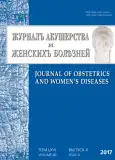The contents of progesterone in the blood of pregnant in I and II trimesters of gestation with an unfavorable outcome of the pregnancy
- Authors: Voskresenskiy S.L.1, Trishina V.L.1
-
Affiliations:
- Belarusian Medical Academy of Postgraduate Education
- Issue: Vol 66, No 4 (2017)
- Pages: 32-39
- Section: Articles
- URL: https://journals.rcsi.science/jowd/article/view/6916
- DOI: https://doi.org/10.17816/JOWD66432-39
- ID: 6916
Cite item
Full Text
Abstract
Relevance. Progesterone is the only hormone in the body, the main function of which is the development and maintenance of pregnancy, while its other properties are duplicated by other hormones. The hormone deficiency is part of the general mechanism of spontaneous abortion, and not its cause [1].
The aim of the study was to establish a connection between the content of the level of progesterone and its metabolites in the blood of pregnant women and the developmental disorders of pregnancy in order to determine the possibility of laboratory confirmation of pathology.
Materials and methods. The study included 31 patients with pathological pregnancy, hospitalized in the hospital, in the first and second trimesters of gestation and 34 women with physiological pregnancy in the first trimester of gestation. Pregnant women with infertility in history, severe somatic pathology, acute infectious diseases, oncological processes, with endocrine disorders, with malformations of the genital organs, endometriosis, pregnant women taking gestagens or other hormonal medications before entering the study are excluded from the study. Each patient hospitalized in a hospital and women with a physiological pregnancy had, in addition to a general clinical examination, performed a blood serum test for hormones (progesterone, cortisol, DHEA-C, 17-OH, estradiol) and ultrasound (VOLUSON 730, GENERAL ELECTRIC in 2007) using transvaginal 4-8 MHz and transabdominal 2–5 MHz sensor. Progesterone, cortisol, estradiol was determined by enzyme-linked fluorescence analysis using reagents from bioMerieux (France) using a VIDAS device from bioMerieux, France (2012). The analysis is based on a combination of a two-stage enzyme-linked immunoassay (sandwich method) and a fluorescent determination of the reaction products. The DHEA-C and 17-OH study was carried out using the ELISA method on equipment: the Freedom EVO75 laboratory automated laboratory for laboratory diagnostics produced in Switzerland (2008) using ANALYSIS MED reagents, Belarus. The statistical processing of the results of the study was carried out using the application statistical packages Statistica 6.0.
Results. It was found that with the termination of pregnancy in both I and II trimesters, the level of progesterone and estradiol statistically significantly decreased. The content of DHEA-S and 17-OH progesterone varied depending on the gestation period. The concentration of cortisol also decreased, but it was not statistically significant. It was also found that after the death of the embryo and spontaneous abortion, functional fragments of the fetal egg remain in the uterine cavity.
Conclusion. The priority of hormones in the development of pregnancy in the I and II trimester is different. If in the first trimester the most dependent on the gestation period are progesterone, estradiol, DHEA-C, then in the II trimester — progesterone, estradiol, 17-progesterone. And also that cortisol during pregnancy is predominantly synthesized outside the fruiting and amniotic complex, which explains the absence of its statistically significant changes in the unfavorable termination of pregnancy in both I and II trimester of gestation.
Full Text
##article.viewOnOriginalSite##About the authors
Sergey L. Voskresenskiy
Belarusian Medical Academy of Postgraduate Education
Author for correspondence.
Email: slv5451@yandex.ru
doctor of medical Sciences, Professor, head of Department of obstetrics and gynecology
Belarus, 220013, Minsk, P.Browki str., 3/3Victoria L. Trishina
Belarusian Medical Academy of Postgraduate Education
Email: viktoria403@bk.ru
leading laboratory of the Department of obstetrics and gynecology
Belarus, 220013, Minsk, P.Browki str., 3/3References
- Репина М.А., Бобров С.А. Значение прогестагенов для акушерской практики // Журнал акушерства и женских болезней. – 2013. – Т. 62. – № 3. – С. 65–69. [Repina MA, Bobrov SA. The role of progestogens in obstetrics practice. Journal of Obstetrics and Women’s Diseases.2013;62(3):65-69. (In Russ.)]
- Кулавский В.А., Кулавский Е.В., Сыртланов И.Р., Никифорова М.В. Репродуктивное здоровье женщин, перенесших неразвивающуюся беременность // Вестник Российского университета дружбы народов. – 2009. – № 7. – С. 64–69. [Kulavskij VA, Kulavskii EV, Syrtlanov IR, Nikiforova MV. Reproduktivnoe zdorov’e zhenshchin, perenesshikh nerazvivayushchuyusya beremennost. Vestnik Rossiiskogo universiteta druzhby narodov. 2009;(7):64-69. (In Russ.)]
- Салов И.А., Аржаева И.А. Особенности метаболизма стероидных гормонов и изменение гормонального статуса плода при преждевременном излитии околоплодных вод // Современные проблемы науки и образования. – 2014. – № 4. [Salov IA, Arzhaeva IA. Circumstances of metabolism rate of steroid hormones and changing hormonal status of a fetus at premature moving of amniotic waters. Sovremennye problemy nauki i obrazovaniya. 2014;(4). Доступно по: https://www.science-education.ru/ru/article/view?id=14309. Ссылка активна на 01.03.2017. (In Russ.)]
- Репина М.А. Прогестерон и беременность // Журнал акушерства и женских болезней. – 2010. – Т. 60. – № 3. – С. 130–135. [Repina MA. Progesteron i beremennost’. Journal of Obstetrics and Women’s Diseases. 2010;60(3):130-135. (In Russ.)]
- Рец Ю.В. Структурно-гормональные проявления хронической плацентарной недостаточности // Акушерство и гинекология. – 2008. – № 5. – C. 28–31. [Rec JuV. Structural and hormonal manifestations of chronic placental insufficiency. Obstetrics and Gynecology. 2008;(5):28-31. (In Russ.)]
Supplementary files







